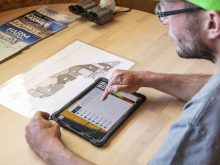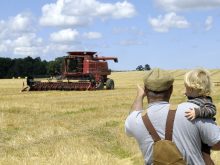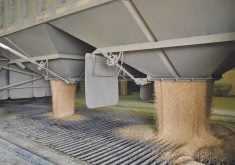Take care of your bones
May has been hectic at our home, as well as at yours, I’m sure. Seeding is well under way. There are outdoor activities and work to do, and our daughters have moved home from university.
When moving furniture and furnishings this month, I was reminded of the need to keep fit and to look after one’s back. Undue stress from improper lifting, straining to reach, or an emotional crisis are common culprits that send backs into painful muscle spasms. When this happens, I pay a visit to a massage therapist. However, prevention works better.
Read Also

Crop profitability looks grim in new outlook
With grain prices depressed, returns per acre are looking dismal on all the major crops with some significantly worse than others.
This winter, I faithfully walked a couple of miles on a treadmill three times a week, did aerobics or equivalent exercise. It’s a start. I feel an overall sense of wellness when I exercise regularly. Walking keeps my back healthy by conditioning and toning the whole body. For me, it also keeps my head healthy. Due to the busy month of moving our daughters, running across the yard, working outside, and using different muscles on the farm, I have had a lot of exercise, but not much opportunity for steady walking. When I deprive myself of this, I miss it and recognize its value.
Walking is an essential part of the healing programs of most back clinics. It works the large muscle groups, which can help to release endorphins that subdue pain, encourage relaxation and bring that feeling of well-being. Walking strengthens postural muscles of the buttocks, legs, back and abdomen. Another top priority for healthy backs is keeping one’s weight under control. Being a fitness walker isn’t a guarantee against straining your back, but it helps.
After a back injury:
- Rest a day or two until it is feeling a bit better.
- Get comfortable sitting or standing for 20 minutes, before you try walking.
- Take short walks at first, being careful not to overdo it. Increase the duration of your walks, day by day.
- Swimming or a stationary bike may work better than walking for some individuals.
- Avoid any back strain during your recovery time.
Source: Prevention Magazine.
We are also focusing on prevention of osteoporosis since it runs in our family. Osteoporosis strikes one woman in four over age 50 and nearly half by age 75. Nearly 1.5 million Canadians (mostly women) suffer from osteoporosis. Most people don’t even know they have it. Bone mass builds to a peak density reached in our late twenties. After age 30, women lose between one and three percent of their bone mass per year. Thin, small-framed caucasian women are more susceptible than others. Anything that interferes with calcium absorption can damage bone and increase the risk.
Smoking and alcohol increase the risks. Smoking lowers estrogen levels. Even caffeine in excess (two or more cups a day) can increase the chances of osteoporosis.
During menopause, estrogen production diminishes, and porous bones are the result. Men can also lose bone mass, especially those with low testosterone levels.
Action taken beyond age 35 can help slow or stop the loss of bone, but cannot reverse it without the use of medications.
Exercise helps build bone mass. When muscles attached to a bone tighten and contract, a bone responds by building denser tissue.
Getting calcium
You are what you eat. This is a well-known fact. As you learned in school, a diet rich in calcium is essential for the building and repair of strong bones and teeth and can prevent osteoporosis.
The remainder of the calcium is distributed throughout the tissues of the body, circulates in the blood and is needed for such functions as hormone production and muscle contraction, including the heartbeat. When there isn’t enough calcium in the organ systems, then the calcium is removed from the bones, weakening them and leading to fractures.
Building bones in your early years is important. When a 500 milligram calcium supplement was added to the daily diets of girls 12-14 years, the rate of bone building was boosted by 20 percent. Doing this for four years could result in a 50 percent reduction in lifetime osteoporosis risk.
Teens should consume 1,200 mg of calcium per day. Health Canada recommends 800 mg for adult women, but the Osteoporosis Society of Canada suggests that daily intake should be raised to 1,000-1,500 mg. One cup of milk has 300 mg of calcium.
For those who can’t tolerate dairy products, supplements can play a vital role. Most experts agree calcium should come from dietary sources rather than supplements because calcium-rich foods provide other nutrients as well.
Nutritious sources of calcium are low or non-fat milk, yogurt, cheese, dark green vegetables (like broccoli), kale and salmon with bones.
Vitamin D is needed by the small intestine to absorb calcium. The Osteoporosis Society of Canada recommends 400-800 international units of vitamin D per day. Milk and margarine are fortified with vitamin D.
Your body can also produce vitamin D between April and October in Canada if you expose your hands and face to the sun for 10-15 minutes a day. Sunscreen of SPF 8 or higher blocks the production of vitamin D.
Many doctors believe the benefits of estrogen replacement therapy outweigh the cancer-causing risks for most women. Before bone densitometry was invented, osteoporosis was detected through routine x-rays or a bone biopsy.
Today, the test known as Bone Mineral Density can tell whether you have osteoporosis, how likely you are to develop it in the future, and help you make decisions that may prevent fractures or further bone loss.
The more risk factors you have, the greater your risk of developing osteoporosis. With the information from your BMD test, you and your health care professional can decide upon the best course of action. If the test shows low bone density, a program of diet, exercise and possibly medication will likely reduce the risk of fracture.
For more information, contact your local public health nutritionist or dietician or: Osteoporosis Society of Canada, Box 280, Station Q, Toronto, Ont., M4T 2M1, 1-800-463-6842.















